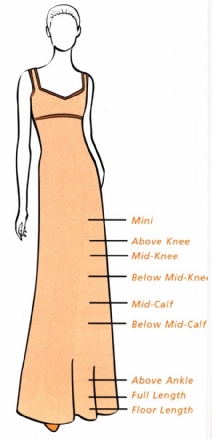|
One of the more important fashion aspects of any garment is its hemline. Although the real purpose of the hem is to help your garments hang well by adding weight to the edge, variations in hem lengths will also change the silhouette and proportion of your garment. |
Skirts and DressesWe wish to emphasize the fact that there is no standard hem length that is correct for every woman. Note: Always let the lengths most becoming to you influence your choice of hem levels. Although fashion and proportion dictate hem lengths, the type of garment, the nature of the fabric, and the height of the wearer determine the depth of the hem. Usually hem allowance is 3” (7.5 cm), which adds weight and therefore influences the drape of the garment. This is suitable for straight garments and for medium and lightweight fabrics. Flared skirts, stretchy fabrics such as knits, and heavier weight fabrics should have a narrower hem of 1-1/2 to 2” (3.8cm to 5cm). Very full or circular skirts need only a 1” (25mm) hem. Narrow rolled hems only 1/8” (3mm) wide or very deep hems up to 6” (15cm) wide are suitable for sheer fabrics. A well-made hem is always the least noticeable hem. Always take the time to eliminate bulk, reduce extra fullness, and press carefully to prevent ridges. Above all, never pull the stitches tightly as you sew.
|
Are you looking for sewing or crafts-related items such as sewing machines, sergers, yarn, and knitting supplies? Try our online catalog pages here.
Or see what products on our site the popular search engines have chosen to list...
- Google listing of all "Sewing" items on our site
- Yahoo! listing
of all "Sewing" items on our site
- Alta Vista listing of all "Sewing" items on our site
Recommended Reading
Recommended Products
5 Drawer Foldaway Desk: Perfect for your sewing machine or serger! Constructed from durable melamine laminated particle board the Mobile Desks will offer a life time of reliable service.
If you need specific sewing supplies, browse through the products on pages like these:
- Brands of Overlock Serger Sewing Machines: Brother Serger and Coverstitch Machines and related items
- Singer Needles for Home Sewing Machines
- Industrial Sewing Machine Accessories
Sleeves
The description on your pattern envelope includes mention of the sleeve length preferred by the designer. Refer to the diagram at left for an explanation of the designer’s length. If a cuff is a part of the design, be sure to take its depth into account in the total sleeve length. Also allow for blousing in a full sleeve.

Keep in mind that the “correct” sleeve length for you is the one that is in proportion to your figure. Sleeves influence the total silhouette of your garment. Their shape, length, and finish can exaggerate a figure flaw or lead the eye away from it.
Here are the suggested lengths that should be used for reference when you are adjusting your pattern or fitting your garment.
Cap: This is a very, very short sleeve, actually an extension of the shoulder and not usually continued under the arm.
Short: The typical short sleeve lies with its lower edge relatively straight across the upper arm.
Above-Elbow: As the name suggests, the arm above the elbow is completely covered by the sleeve.
Three-Quarter: This sleeve is three-fourths the length of the arm. It ends halfway between the elbow and the wrist bone.
Seven-Eighths: A sleeve which terminates approximately 2” (5 cm) above the wrist bone or halfway between the three-quarter and the long sleeve.
Wrist Length: This sleeve grazes the wrist just at the prominent wrist bone.
Long or Full Length: Falls 1” (25 mm) below the wrist bone at a comfortable length before reaching the hand.
Pants
The length of your pants or shorts is important to your total look.
- Full-length pants that are too short can have a skimpy, “out-grown” look.
- Pants that are too long can be clumsy and troublesome.
- Make sure your shorts and below knee length pants do not end at an unattractive point on your leg. Sometimes, even an adjustment of 1/2 (13mm) in length can make a world of difference in their attractiveness.


